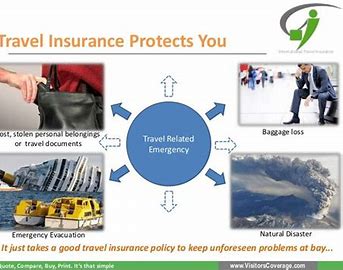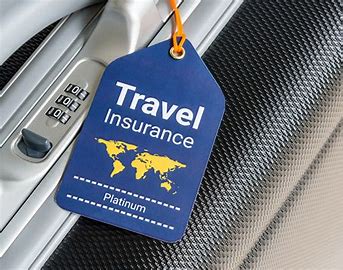Introduction:
Travel insurance serves as a vital safety net for travelers in the
United States, providing coverage for unforeseen events, emergencies,
and disruptions during domestic and international trips.
Whether for leisure, business, or study abroad, travelers face various risks ranging from trip cancellations and medical emergencies to lost baggage and travel delays. In this essay, we delve into the multifaceted landscape of travel insurance in the USA, examining its significance, types, coverage options, pricing factors, regulations, challenges, and future trends.
Importance of Travel Insurance:
Travel insurance plays a crucial role in mitigating financial risks and ensuring peace of mind for travelers, offering protection against a wide range of potential hazards and uncertainties:

- Trip Protection: Travel insurance provides coverage for trip cancellations, interruptions, or delays due to unforeseen circumstances such as illness, injury, death, natural disasters, terrorist attacks, or travel advisories. By reimbursing non-refundable trip expenses, including airfare, accommodations, and pre-paid activities, travel insurance helps travelers recoup financial losses and avoid additional expenses incurred due to unforeseen disruptions.
- Emergency Medical Assistance: Travel insurance offers emergency medical coverage for travelers who experience illness or injury while away from home. Medical benefits may include coverage for hospitalization, physician services, prescription medications, emergency medical evacuation, repatriation of remains, and dental emergencies. Travel insurance ensures access to quality healthcare services and timely assistance in unfamiliar destinations, reducing the financial and logistical burdens of medical emergencies abroad.
- Baggage and Personal Belongings: Travel insurance provides coverage for lost, stolen, or damaged baggage and personal belongings during transit or while at the destination. Baggage insurance reimburses travelers for the cost of replacing essential items such as clothing, toiletries, electronics, and travel documents lost or delayed by airlines or other carriers. Additionally, travel insurance may offer coverage for baggage delay, allowing travelers to purchase essential items while waiting for their luggage to be recovered or delivered.
- Travel Assistance Services: Travel insurance includes access to travel assistance services, such as 24/7 emergency assistance hotlines staffed by multilingual coordinators and medical professionals. Travel assistance services provide guidance, support, and coordination of emergency medical care, legal assistance, travel arrangements, and communication with family members or employers during travel-related emergencies.
Types of Travel Insurance Coverage:
Travel insurance policies in the USA offer various types of coverage to address different travel-related risks and protection needs for travelers. Common types of travel insurance coverage include:

- Trip Cancellation and Interruption Insurance: Trip cancellation and interruption insurance reimburses travelers for non-refundable trip expenses if they are unable to travel or must cut their trip short due to covered reasons such as illness, injury, death, weather-related disruptions, or travel advisories. Covered expenses may include airfare, hotel accommodations, tour packages, and pre-paid activities, up to the policy’s maximum limits.
- Emergency Medical Insurance: Emergency medical insurance provides coverage for medical expenses incurred by travelers due to illness or injury while traveling abroad. Medical benefits may include hospitalization, physician services, diagnostic tests, prescription medications, emergency medical evacuation, repatriation of remains, and dental treatment. Emergency medical insurance ensures access to necessary healthcare services and financial protection against unexpected medical costs while away from home.
- Baggage and Personal Effects Insurance: Baggage and personal effects insurance reimburses travelers for lost, stolen, or damaged baggage and personal belongings during transit or while at the destination. Coverage typically includes reimbursement for the cost of replacing essential items such as clothing, toiletries, electronics, and travel documents. Additionally, baggage insurance may offer coverage for baggage delay, providing reimbursement for essential items purchased during the delay period.
- Travel Delay and Missed Connection Insurance: Travel delay and missed connection insurance provides coverage for additional expenses incurred due to travel delays or missed connections caused by covered reasons such as weather-related disruptions, mechanical failures, or airline strikes. Covered expenses may include meals, accommodations, transportation, and incidental expenses incurred during the delay period.
- Emergency Assistance and Travel Services: Emergency assistance and travel services provide travelers with access to 24/7 assistance hotlines staffed by trained professionals who can provide medical referrals, travel advice, legal assistance, emergency cash advances, translation services, and travel arrangements. Travel assistance services ensure that travelers receive timely support and assistance in navigating travel-related emergencies and unforeseen disruptions.
Coverage Options and Considerations:
When selecting travel insurance coverage, travelers should consider several factors to ensure adequate protection and alignment with their travel plans, preferences, and budget:
- Coverage Limits and Exclusions: Review the coverage limits, exclusions, and conditions specified in the policy to understand the scope of coverage and potential limitations. Pay attention to coverage limits for trip expenses, medical benefits, baggage claims, and other covered risks, as well as exclusions for pre-existing conditions, high-risk activities, and hazardous destinations.
- Pre-Existing Medical Conditions: Be aware of how travel insurance policies define and handle pre-existing medical conditions, which are health conditions or symptoms existing before the policy’s effective date. Some policies may exclude coverage for pre-existing conditions entirely, while others may offer limited coverage or require a waiting period before coverage applies.
- Deductibles and Coinsurance: Understand the deductible and coinsurance requirements specified in the policy, which represent the amount of out-of-pocket expenses that travelers must pay before insurance benefits apply. Higher deductibles and coinsurance percentages typically result in lower premiums but may require travelers to bear a greater share of covered expenses.
- Trip Duration and Destination: Consider the duration of the trip and the destination’s geographical location, travel advisories, and healthcare infrastructure when selecting travel insurance coverage. Longer trips, international travel, and travel to remote or high-risk destinations may warrant higher coverage limits and comprehensive insurance protection.
- Provider Reputation and Customer Service: Research travel insurance providers’ reputations, customer reviews, financial stability ratings, and claims processing procedures to assess their reliability, responsiveness, and customer service quality. Choose a reputable insurer with a track record of timely claims settlement, customer satisfaction, and assistance during travel-related emergencies.

Key Markets and Trends in Travel Insurance:
The travel insurance market in the USA is dynamic and evolving, influenced by various market trends, consumer behaviors, industry innovations, and regulatory developments:
- Market Growth and Adoption: The travel insurance market in the USA has experienced steady growth in recent years, driven by increasing travel demand, awareness of travel risks, and the availability of comprehensive insurance products. As travelers become more cognizant of the importance of travel insurance in protecting their trips and investments, market adoption rates continue to rise across diverse demographics and travel segments.
- Personalization and Customization: Insurers are offering more personalized and customizable travel insurance options to meet travelers’ unique needs, preferences, and risk profiles. Customization features may include flexible coverage limits, optional endorsements, add-on benefits, and tailored policy terms to accommodate travelers’ specific travel plans, destinations, and activities. Personalized insurance solutions ensure that travelers receive adequate protection and peace of mind while on the road.
- Pandemic Preparedness and Coverage: The COVID-19 pandemic has reshaped the travel insurance landscape, prompting insurers to introduce new products and coverage options to address pandemic-related risks and uncertainties. Pandemic coverage may include benefits for trip cancellations, interruptions, or medical expenses resulting from COVID-19 infection, quarantine requirements, border closures, or travel advisories. Insurers are also offering “Cancel for Any Reason” (CFAR) coverage, which allows travelers to cancel their trip for any reason not covered by standard policies and receive partial reimbursement of non-refundable expenses.
- Digitalization and Technological Integration: Advancements in technology, digital platforms, and mobile applications are revolutionizing the travel insurance industry’s distribution channels, customer engagement, and claims processing capabilities. Insurers are leveraging digital tools, online portals, and mobile apps to streamline policy sales, manage travel documents, provide real-time assistance, and facilitate contactless claims submissions. Digital innovations enhance accessibility, convenience, and transparency for travelers seeking insurance protection and support during their journeys.
- Regulatory Compliance and Consumer Protection: As the travel insurance market expands, regulatory oversight and consumer protection measures aim to safeguard travelers’ interests, ensure fair treatment, and promote market transparency. State insurance regulators monitor insurers’ practices, disclosures, claims handling procedures, and financial solvency to uphold industry standards and protect consumers from fraud, misrepresentation, and unfair business practices. Regulatory initiatives focus on enhancing policy transparency, disclosure requirements, and consumer education to empower travelers to make informed decisions about their insurance coverage.

Conclusion:
Travel insurance plays a critical role in mitigating travel-related risks, ensuring financial protection, and providing peace of mind for travelers in the USA. By offering coverage for trip cancellations, medical emergencies, lost baggage, and travel disruptions, travel insurance enables travelers to explore the world with confidence and security. As the travel insurance market continues to evolve, insurers, regulators, and consumers must collaborate to address emerging challenges, promote innovation, and enhance consumer protection. Through innovation, customization, and regulatory oversight, travel insurance remains a trusted companion for travelers, supporting safe, enjoyable, and worry-free journeys around the globe.



